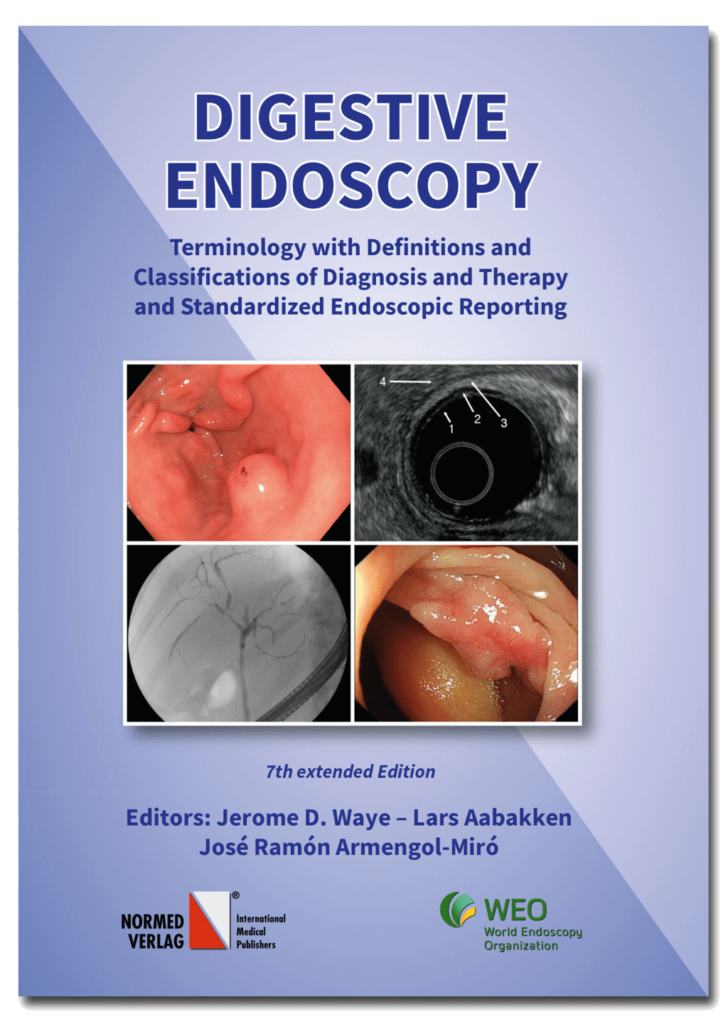Digestive Endoscopy
Terminology with Definitions and Classifications of Diagnosis and Therapy and Standardized Endoscopic Reporting, 7th extended edition 2021
- Editors: Waye, Jerome D. / Armengol Miró, José Ramon / Aabakken, Lars
- ISBN: 978-3-89199-100-8 (Softcover)
978-0-920592-29-2 (Softcover) - Status: on stock
- Publication Date Dec. 2021
- Product form: Book
- Language: English
- Pages: 253
- Pictures: total 289, Colour 186, Drawings 106
- Binding: Softcover
- Price: EUR: 46,00

Contents
Terminology is a vocabulary of words used in a specific context. There are vague terms used in romance or theater and very specific terms used in science while descriptive terms are employed in the field of endoscopy. Terminology in endoscopy is intended to paint a picture of what is seen during the procedure. The language must be universally acceptable, and the descriptive terms have to create the same picture in Barcelona as in Baltimore. The terms used to describe the endoscopic findings must point toward a diagnosis of a condition such as inflammatory or neoplastic and contain sufficient information to permit the reader or listener to know exactly what the examiner saw and to draw their own conclusion about the most probable pathology and to plan the next phase of investigation or treatment. The doyen of endoscopic terminology is Professor Zdenek Mařatka, who recognized the value of the language of endoscopy even before the introduction of flexible endoscopes.
Professor Mařatka formulated lists of endoscopic findings and being a highly educated European gastroenterologist, knew the meaning of the terms he used in several languages. He often lectured at conferences around the world and brought his convictions about the terminology of endoscopy to the World Congress of Digestive Endoscopy in Madrid in 1978 where his views were embraced. Several international organizations recognized the importance of specific endoscopic terminology at a time when the field of flexible fiberoptic endoscopy was growing rapidly and computers were beginning to be used to generate reports across the world. The European Society for Gas- trointestinal Endoscopy and the American Society for Gastrointestinal Endoscopy appointed new committees on nomenclature and the World Organization of Digestive Endoscopy (now known as WEO, the World Endoscopy Organization) took on the role of administering the thrust for a universal nomenclature.
The World Organization of Endoscopy took on the role of the guardian of endoscopic terminology under their “Documentation and Standardization Committee” which has developed a universally accepted “Minimal Standard Terminology” for all aspects of endoscopy. “Minimal” refers to the shortest list of words that can be used to describe findings throughout the entire field of gastrointestinal endoscopy and that are universally accepted throughout the entire world. The Minimal Standard Terminology is intended to be the list of terms to be used for all computer generated reports and avoids confusion in terms of common language usage. The MST uses descriptive words such as “erythema” and avoids other descriptive adjectives such as “redness”, “angry looking”, “irritation” or any specific pathology diagnosis like “gastritis” or “Crohn’s Disease”. It is necessary that words in any language convey the same meaning and this is assured by the WEO Committee on Documentation and Standardization. All of the authors of this book on Terminology have served on this committee, and Professor Aabakken has served as its chairman.
The Minimal Standard Terminology (MST) can be accessed and downloaded on the World Endoscopy Organization website (http://www.worldendo.org). An excerpt of the Introduction to the MST is copied here:
“ The major aim of the project was to devise a ‘minimal’ list of terms that could be included within any computer system used to record the results of a gastrointestinal endoscopic examination. The lists should not be exhaustive, and the work should not result in complete software. Rather, the MST should for the basis for various software vendors to facilitate common structure and language. In addition, the MST should provide assistance in the standardization of endoscopic image storage and transfer between individual systems and in the structure of reports. The list of terms proposed relied heavily upon the original and detailed work performed by the WEO (formerly known as OMED) committee under the chairmanship and guidance of Pr. Z. Mařatka. His book provides the framework, as well as the definitions for most of the MST terminology. This will provide a reference for users unfamiliar with the words employed.”
Terminology evolves over the years, and terms which were used in the past may not be acceptable in view of new developments or new instruments. We have strived to keep the basic considerations of the founders of modern terminology intact, and to provide both visual and descriptive versions of the diagnostic and therapeutic aspects of endoscopy in this book. To facilitate both learning and clinical practice, this book is also complemented by a scholarly organized multilingual multimedia DVD-ROM. This contains annotated images and videos of procedures in up to five languages including the latest techniques of N.O.T.E.S.
Jerome D. Waye, MD Lars Aabakken, MD José R. Armengol-Miro, MD
